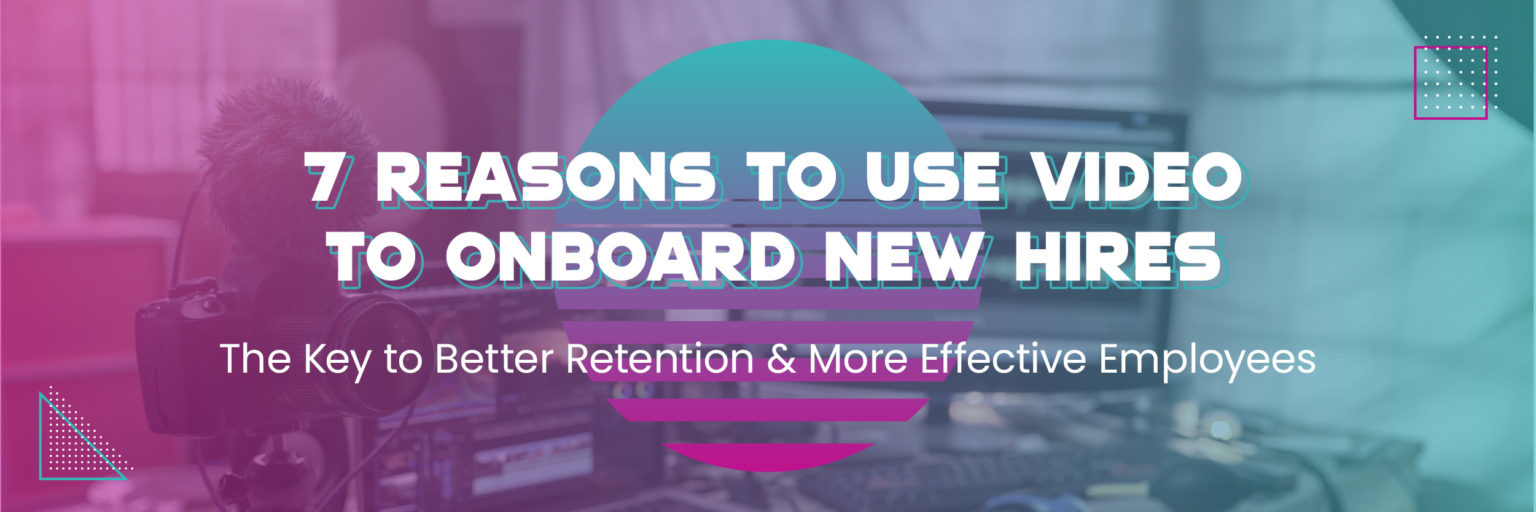Do you want employees that are more effective in their roles, stick around longer, and bring more value to your company? Of course you do! And video is the key to making that dream a reality.
Training and onboarding are crucial processes for any company. They ensure that employees have the skills and knowledge needed to succeed in their roles. However, traditional training methods like in-person sessions and lengthy manuals can be time-consuming and ineffective, leading to a lack of engagement and worse and more costly for your business, a lack of employee retention. This is where video comes in – video is a powerful tool for training and onboarding employees. Video can help you to improve employee engagement, retention, and get faster results from new hires without breaking the bank. We might be a little biased around here, but today we’re covering our top 7 reasons why your company should use video in your training and onboarding processes. Let’s jump in.
- Increased Engagement
Video is a highly engaging medium that can capture the attention of learners and hold it much better than text or images alone. By incorporating video into your training and onboarding processes, you can create more engaging and interactive learning experiences that keep viewers interested and motivated. We are guilty of scrolling Instagram during group onboarding meetings or barely reading a training manual, and frankly we’re confident your employees are guilty of the same. So toss out that text-only onboarding and training course and jazz it up with video supplements that showcase your company culture and drive higher levels of engagement, retention, and overall success for your new hires.
- Consistent Messaging
With video, you can ensure that your messaging is consistent across all learners, regardless of location or time zone. By adding video to your training materials you can ensure that everyone is receiving the same information in the same way, which can help to eliminate confusion and ensure that all learners are on the same page. There are also a number of resources for localizing video content to multiple languages and regions all over the world for businesses training a global pool of talent. If your business has to train employees on specific procedures and processes, video is the ultimate tool since 95% of a message is retained when consumed via video compared to other mediums.
- Scalability
Video is a highly scalable tool despite what many may think and it can be used to train large groups of learners quickly and efficiently. With video, you can create a library of pre-recorded content that can be accessed by learners at any time, from anywhere, allowing you to train employees in multiple locations or time zones without the need for in-person sessions or travel. With the rise of services like Kajabi, Thinkific, Master Class, Teachable, Skill Share and others, online learning via video has become normalized and frankly, expected, by people accross every industry.
- Cost-Effective
We know most people think video is a big investment and hard to keep up-to-date but video can be a cost-effective tool for training and onboarding, especially when compared to in-person sessions, live calls, or creating lengthy manuals. Teaching via video is almost always faster and easier for your instructors, and updating and maintaining a video database of training material is easy to do with services like Wistia that offer the ability to replace a video file without ever changing the link or URL. You can easily batch out an entire training module in a day with a good video producer, have it edited and live within 30 days, and immediately reduce the need for expensive in-person or live sessions or any associated training travel.
- Improved Retention
Studies have shown that learners are more likely to remember information presented in video form than in text or audio alone, it’s literally our favorite stat ever, 95% of a message is retained when consumed via video than via other mediums. This makes video the most powerful tool for improving retention and ensuring that learners are able to apply what they’ve learned in real-world situations more quickly and naturally than if they had been trained via written material. Employees that are better equipped to succeed in their roles are proven to stay longer in those roles and bring more value to your organization.
- Flexibility
Video is a flexible tool that can be used in a variety of ways to meet the needs of different learners. For example, you can use video to provide high-level overviews of key processes, or to provide more detailed explanations of complex topics. Video training doesn’t mean that your employees are looking at a talking head the whole time, well produced video training can incorporate on-site technical training, screen recordings, and talking head or even white board sessions to make sure that your training material is conveyed in the most accurate and appropriate way possible. Video has the unique ability to capture and demonstrate processes in action and in real-time, allowing learners to see exactly how things should be done and what to actually expect when they begin tackling those actions themselves.
- Personalization
There is nothing more personal than video. It allows you or your training team to connect with new hires in ways that are only rivaled by in-person interactions. Post-pandemic, people have an inherit desire to connect with people on a personal level. With video, you can create personalized learning experiences that cater to the unique needs and preferences of individual learners. For example, you can create custom playlists of videos that are tailored to the specific roles or departments that feature the actual team they will be working with or reporting to, building that relationship before they even start their day-to-day work. You can also create interactive videos that allow learners to choose their own paths through the content, viewing videos in a sequence that they define themselves.
We told you at the start of this post we are a tad biased around here. We truly believe video is the key to create a better experience for everyone trying to do business in the mordern market. Most companies think of video as a tool for capturing attention, collecting leads, and moving prospects through the funnel but turning that same strategy inward, there is a lot of opportunity to better cement your comany culture and values and create better trained employees. Video is a powerful tool offering a range of benefits that can help companies to improve engagement, retention, and ultimately results. If you’d like to learn more about how a video onboarding and training library can help your business, we’d love to talk with you, and if you want to go it alone, we get it, Zoom and Loom and the other “oom” apps out there are here to help and we hope this post gave you some ideas on how to implement video into your organization.


